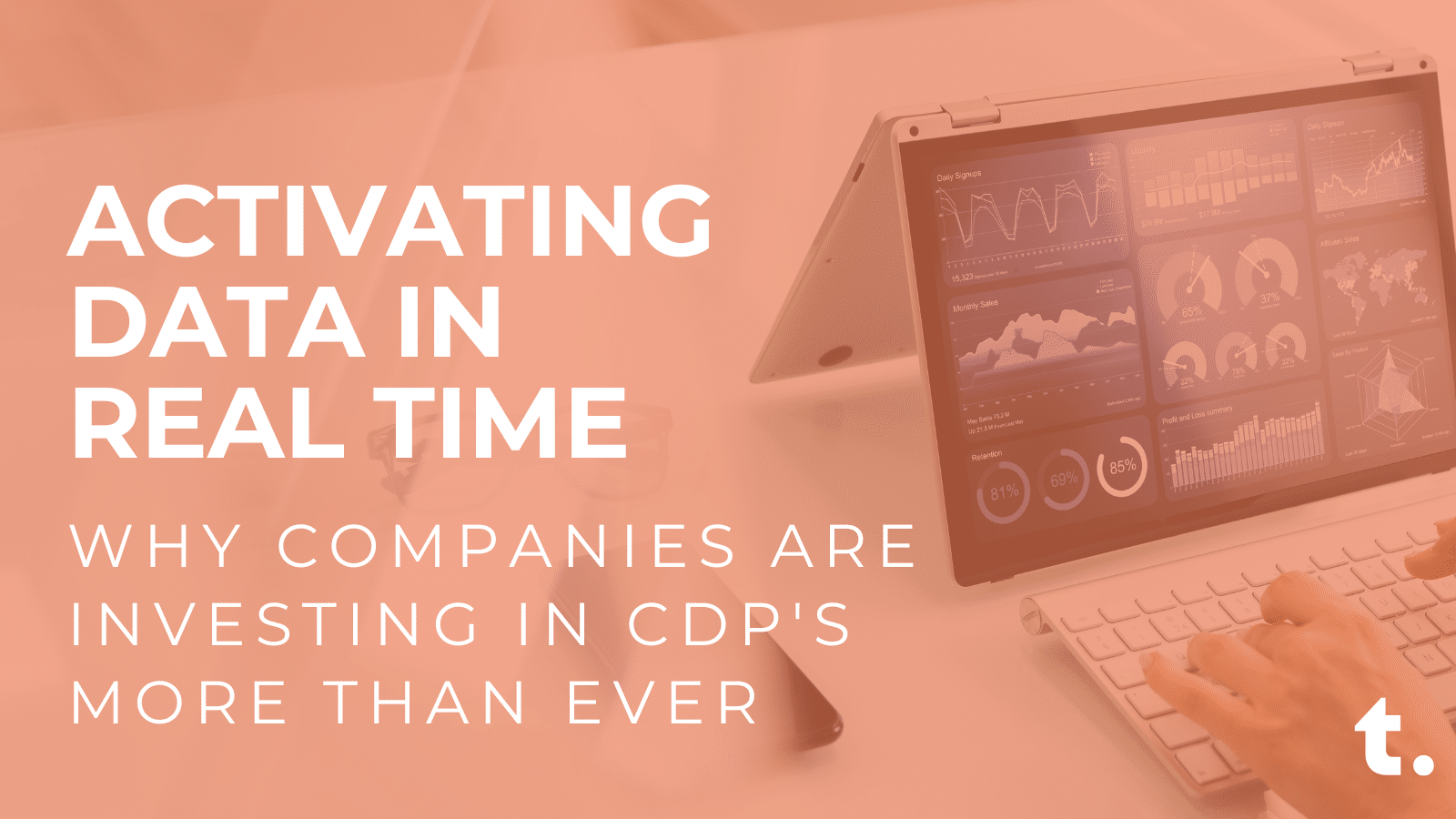Salesforce’s latest announcement, the brand new Genie platform, has caused quite a stir – not just in the Salesforce community, but in the general sales, marketing and service arenas.
But why?
In an environment where businesses are constantly battling for the attention of their target audience (and where third-party cookies are on their way out of the door), the ability to collect, analyse and act on data in real-time has never been more valuable.
Thanks to their real-time applications, Customer Data Platforms (CDPs) are currently leading the race in sales, marketing and customer services. But, as with any new platform, it is important to start by outlining the problems you are looking to solve along with your success measures. For example, “as an X, I want to Y so that I can Z”. Find out more about the importance of customer journey mapping and goal setting here.
The next step is to review whether a CDP will help you meet these goals before devising a roadmap for the implementation and operation of the platform. We generally recommend starting with building out 1-2 use cases to realise a faster return on investment, while getting a feel for the full potential of what’s possible.
In today’s blog, we explore exactly what a CDP is, how they differ from DMPs, and why they have become so popular.
What is a CDP?
A CDP (customer data platform) allows you to have a 360-degree view of your customer by combining data from multiple sources like your website, social media, email, sales and customer service touchpoints into a single centralised database..
The purpose of a connected platform is to enable businesses to truly understand the customer from every touch point, when they first engage, behaviour over time, likelihood to return, and intent/sentiment towards your product or service for example. This allows you to segment data and build personalised real-time marketing campaigns that will increase the lifetime value of your customers. Plus, it can package it all up in the correct format for any other marketing system that might need it – like social media ads platforms, for example.
What Is A DMP And How Is It Different To A CDP?
Similarly to a CDP, a DMP (data management platform) collates, organises and activates data from various online, offline and mobile sources. It uses this data to create customised customer profiles which can be applied to advertising platforms (ie. Google Ads, Facebook Ads and so on). However, unlike CDPs, this data can only be applied to advertising platforms, rather than any platform that needs it (i.e. marketing, sales, customer service applications).
In contrast to CDPs, DMPs cannot activate and apply the data to real-time situations to create personalised marketing experiences, which make a huge difference in today’s dynamic targeting-heavy advertising world. Plus, DMPs are designed to build profiles of anonymous individuals, so they don’t attach Personally Identifiable Information (PII) to their customer profiles (unlike CDPs, which are able to). This prevents users of these platforms from carrying out many of the potential targeting activities that they could do with a CDP – for example, serving up a personalised ad by using someone’s first name to get their attention, just like Channel 4 did some time ago on their VoD platform, All4.
Why Are CDPs So Popular Right Now?
There are a few reasons why CDPs are rising in popularity in the MarTech space, but two of them stand head-and-shoulders above the rest when it comes to providing real value for marketers. These are…
1. They help businesses to understand customer behaviour better, allowing them to:
- Provide consistent messaging across multiple channels (including sales, marketing and customer services) that improves brand perception and increases visibility
- Create personalised experiences to build brand trust and enhance the customer’s interactions with the brand
- Build lookalike models to identify and target other valuable customers when advertising
- Be more aware of the way customers behave by analysing their touchpoints and journey through various marketing means
2. They bring data together from multiple sources in real-time, allowing businesses to:
- Target customers at the right time and with the right message, so they’re more likely to convert and increase customer lifetime value
- Develop a better relationship with customers and their experience of the brand, encouraging loyalty and trust in the brand
- Connect to their customers on a more personal level and how they behave online
There’s one benefit of CDPs, in particular, that is most valuable – the ability to activate and personalise data to improve customer experience in real time. Whilst data might be different when collated from varying sources, the CDP works to unify and align this information as soon as it is made available, and at scale.
Let’s explore this with a couple of examples…
Example 1: Starbucks Lovers Rejoice!
Imagine you’re a regular Starbucks customer. So regular, in fact, that you buy the same Oat Latte every 3 days. You use the Starbucks App so that you can order ahead and save yourself queueing in the cafe and because you love to collect loyalty points.
Here’s how a CDP would help Starbucks to turn you from a regular customer into a full-on superfan…
Stage 1 > With a CDP, Starbucks brings together the information they have about you, your shopping behaviour and your phone’s geo-location to send you a friendly notification the next time you walk past a Starbucks on one of your usual non-coffee days.
Stage 2 > They might then send you a coupon code for a discount or a free Oat Latte, just to say thanks for being such a loyal customer.
Stage 3 > You’ll probably see this coupon, be very happy about it, and then pop over to their cafe on a day you wouldn’t usually visit.
The result? An enhanced, personalised customer experience, increased customer loyalty and potentially a few extra pennies for Starbucks when you decide to purchase a vegan brownie to go with that Oat Latte.
Example 2: Fancy A McDonalds?
Another example? Oh, go on then…
Stage 1 > Say you’re a fan of a Mcdonald’s and you usually use the Deliveroo app to order yourself a Big Mac Meal once a month or so. Except this month you missed your monthly Maccies. You’re on your way home from work and it’s around dinner-time (the time you’d normally order your delivery). You’re not far from home and you pass a bus stop. Thanks to a CDP, McDonalds knows all of this and has made the connections between all of this data.
Stage 2> As you’re walking past, you see an ad flash up on the bus stop’s digital OOH board. It says “Hey, [YOUR NAME]! Did you miss me?” with a lovely big picture of that tasty Big Mac on the screen.
Stage 3 > Seeing your name makes you stop in your tracks. Then you see that Big Mac and remember you’ve not treated yourself this month. You’re instantly hungry and impressed with McDonalds’ and their clever marketing team. You promptly make an order.
With CDPs, brands can go far beyond traditional means of marketing to target their ideal audiences – taking ad personalisation to a whole new level. What’s more, it can all be automated (and in real-time).
Where Does Salesforce Come In?
As the world’s #1 CRM, Salesforce knows a thing or two about managing customer relationships, and the Salesforce CDP is no exception. Built on a unified, connected platform, Salesforce’s Marketing Cloud is an intelligent marketing automation tool that adapts to your customer’s changing behaviour by delivering personalised, audience-specific messages (informed by first, second and third-party customer data from a variety of sources) at the right moment.
—
To find out more about how Salesforce can help your business boost sales, improve ROI and improve customer experience (and how Trigg Digital can help you to implement it seamlessly into your existing processes), get in touch!
+44 203 239 8492
hello@triggdigital.com
- ASOS Media Group Taps Trigg Digital as a Strategic Salesforce Partner - April 22, 2025
- Documill and Trigg announce strategic partnership to simplify the complexity of document management - February 13, 2025
- #TriggThoughtLeaders – Retail Media Deep Dive with Chris Quinn, Co-founder, ProOps Consulting - February 4, 2025



